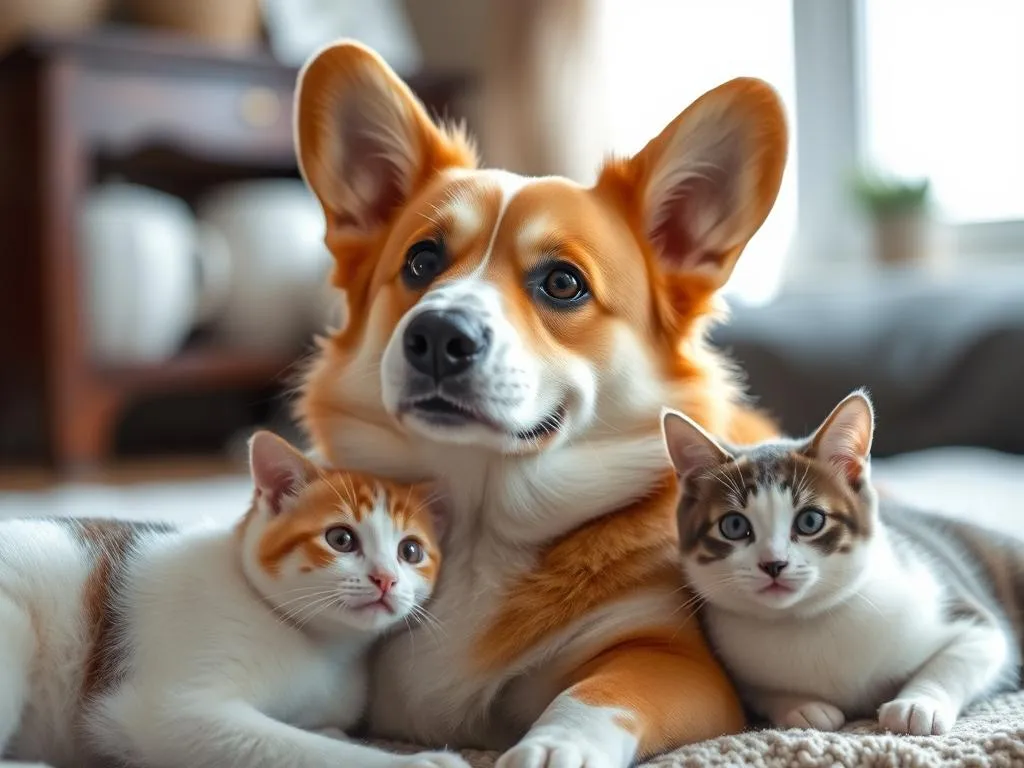
Understanding the dynamics between different pet species is crucial for pet owners, especially when considering adding a new member to the family. One common question that arises is: will a corgi be good with my cats? Corgis, known for their playful and affectionate nature, have unique traits that influence how they interact with feline companions. This article delves into the characteristics of Corgis, their behaviors, and factors that can impact their compatibility with cats.
Understanding Corgis
Origin and History
Corgis have a rich history that dates back to the 10th century in Wales. Originally bred as herding dogs, they were instrumental in managing livestock, particularly cattle. Their low stature allowed them to nip at the heels of larger animals while avoiding kicks, making them effective workers on farms. Beyond their herding roles, Corgis have also served as faithful companions to the nobility, including Queen Elizabeth II, who has had a lifelong affinity for the breed.
Characteristics of Corgis
Corgis are small to medium-sized dogs, typically weighing between 25 to 30 pounds. They have a distinctive appearance with short legs, a long body, and large, erect ears. Their coat can be either Pembroke or Cardigan, showcasing a range of colors from fawn to black and tan.
In terms of temperament, Corgis are known for their intelligence, loyalty, and playful demeanor. They are energetic dogs that thrive on exercise, requiring daily walks and playtime to keep them physically and mentally stimulated. Their friendly nature makes them excellent companions, but this same energy can sometimes lead to challenges when integrating them with other pets, particularly cats.
General Behavior of Corgis
Social Behavior
Corgis are generally social dogs, often getting along well with humans and other animals. They tend to be friendly and outgoing, which can be a positive trait when introducing them to a cat. However, their herding instincts may come into play, leading them to be overly enthusiastic around smaller animals.
Herding Instincts
As a herding breed, Corgis possess a natural instinct to herd, which can manifest in different ways. This instinct may lead them to chase after moving objects, including cats. While this behavior is not inherently aggressive, it can result in stress for both the Corgi and the cat if not properly managed. Understanding this aspect of their behavior is crucial for pet owners considering the compatibility of a Corgi with their feline friends.
Factors Influencing Corgi-Cat Compatibility
Corgi’s Temperament
Not all Corgis have the same temperament. Individual personalities can vary significantly within the breed. Some Corgis are more laid-back and adaptable, while others may be more excitable and assertive. Proper training and socialization are vital in shaping a Corgi’s behavior, especially regarding their interactions with cats.
Cat’s Personality
Just as Corgis have varied temperaments, so do cats. Some cats are more social and open to new experiences, while others may be more reserved or territorial. A cat that has had positive experiences with dogs in the past may adapt more easily to a new Corgi companion. Understanding your cat’s personality is essential in assessing their compatibility with a Corgi.
Early Socialization
Introducing a Corgi to a cat at a young age can lead to more harmonious relationships. Ideally, Corgis should be socialized with cats during their critical developmental period, which is typically between 3 and 14 weeks of age. Early exposure can help them learn appropriate behaviors around cats, reducing the likelihood of chasing or aggressive interactions later on.
Living Environment
The home environment plays a significant role in the success of a Corgi-cat relationship. Ensuring that both pets have their own space can minimize stress. Providing safe zones for the cat, where they can retreat if they feel threatened, is crucial. A well-structured living environment will help both pets coexist peacefully.
Preparing for a Corgi-Cat Introduction
Assessing Your Cat’s Behavior
Before introducing a Corgi to your cat, it’s important to assess your cat’s behavior. Look for signs that indicate adaptability, such as curiosity towards new animals or a generally calm demeanor. Cats that are more confident and less territorial may have an easier time adjusting to a new dog.
Introducing Corgis and Cats
The introduction process should be gradual and carefully managed. Here’s a step-by-step guide to help facilitate a successful introduction:
-
Prepare Separate Spaces: Initially, keep the Corgi and cat in separate areas of the house to allow them to acclimate to each other’s scents without direct contact.
-
Scent Swapping: Exchange bedding or toys between the two pets to help them get used to each other’s scent.
-
Controlled Introductions: When ready, introduce them in a controlled environment. Use a leash for the Corgi and allow the cat to explore at their own pace.
-
Positive Reinforcement: Reward both pets with treats and praise for calm behavior during the introduction process.
-
Short Sessions: Keep initial interactions short and gradually increase the time they spend together as they become more comfortable.
Monitoring Interactions
Supervision is critical during the initial interactions between a Corgi and a cat. Watch for signs of stress or discomfort in either pet. If the Corgi appears overly excited or the cat seems frightened, it’s essential to separate them and try again later. Signs of stress in cats can include hiding, hissing, or swatting, while Corgis may bark excessively or exhibit hyperactive behavior.
Tips for Successful Coexistence
Training Your Corgi
Training is an essential aspect of ensuring a harmonious relationship between your Corgi and cat. Basic obedience commands such as “sit,” “stay,” and “leave it” can help manage your Corgi’s behavior. Additionally, specific training focused on interactions with cats can be beneficial. Teaching your Corgi to remain calm and to refrain from chasing the cat can lead to a more peaceful coexistence.
Creating Safe Spaces
Establishing safe spaces for both pets is crucial. Cats often feel safer when they have high places to retreat to, such as cat trees or shelves. Corgis should have designated areas where they can relax without being disturbed. Creating physical barriers, like baby gates, can also provide a sense of security for both pets during the adjustment period.
Building Positive Associations
Encouraging positive associations between your Corgi and cat can help foster a good relationship. Use treats and praise to reinforce positive interactions. For instance, if your Corgi calmly observes the cat, reward them with a treat. Conversely, if the Corgi becomes too excited, redirect their attention to a toy or command them to sit. This training helps to build a positive environment for both pets.
Common Concerns and Misconceptions
Aggression towards Cats
One common concern among cat owners is the fear that Corgis may be aggressive towards cats. While Corgis can display herding behaviors that may appear aggressive, they are generally not predisposed to aggression. Proper training, socialization, and understanding of their behavior can mitigate these concerns.
Managing Prey Drive
Corgis have a natural prey drive, which can lead them to chase small animals, including cats. This instinct can be managed with proper training and supervision. It’s essential to redirect their focus when they display chasing behavior and to reinforce calm interactions with the cat. Understanding this instinct is key to preventing unwanted incidents in a multi-pet household.
Conclusion
In summary, the question of will a corgi be good with my cats largely depends on individual circumstances, including the specific personalities of both the Corgi and the cat, as well as the training and socialization provided. With the right approach, many Corgis and cats can coexist peacefully and even form strong bonds. By understanding the unique characteristics of Corgis, their behaviors, and the factors influencing compatibility, cat owners can make informed decisions and create harmonious multi-pet households. Remember, patience and a gradual introduction process are essential for success.









